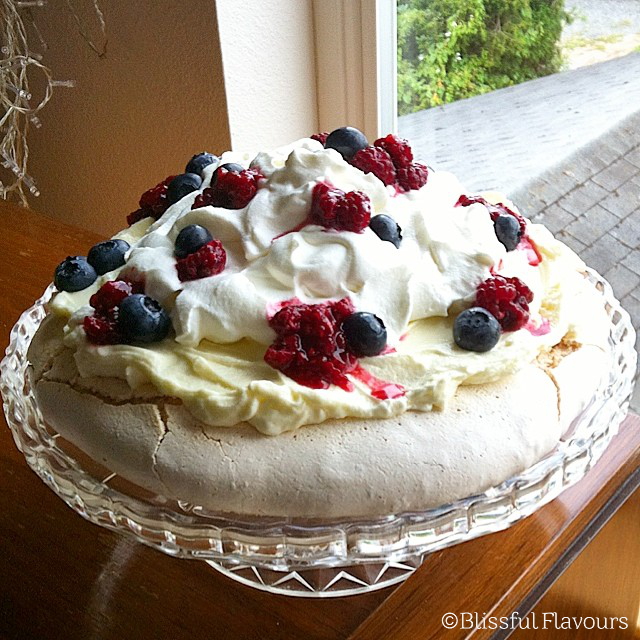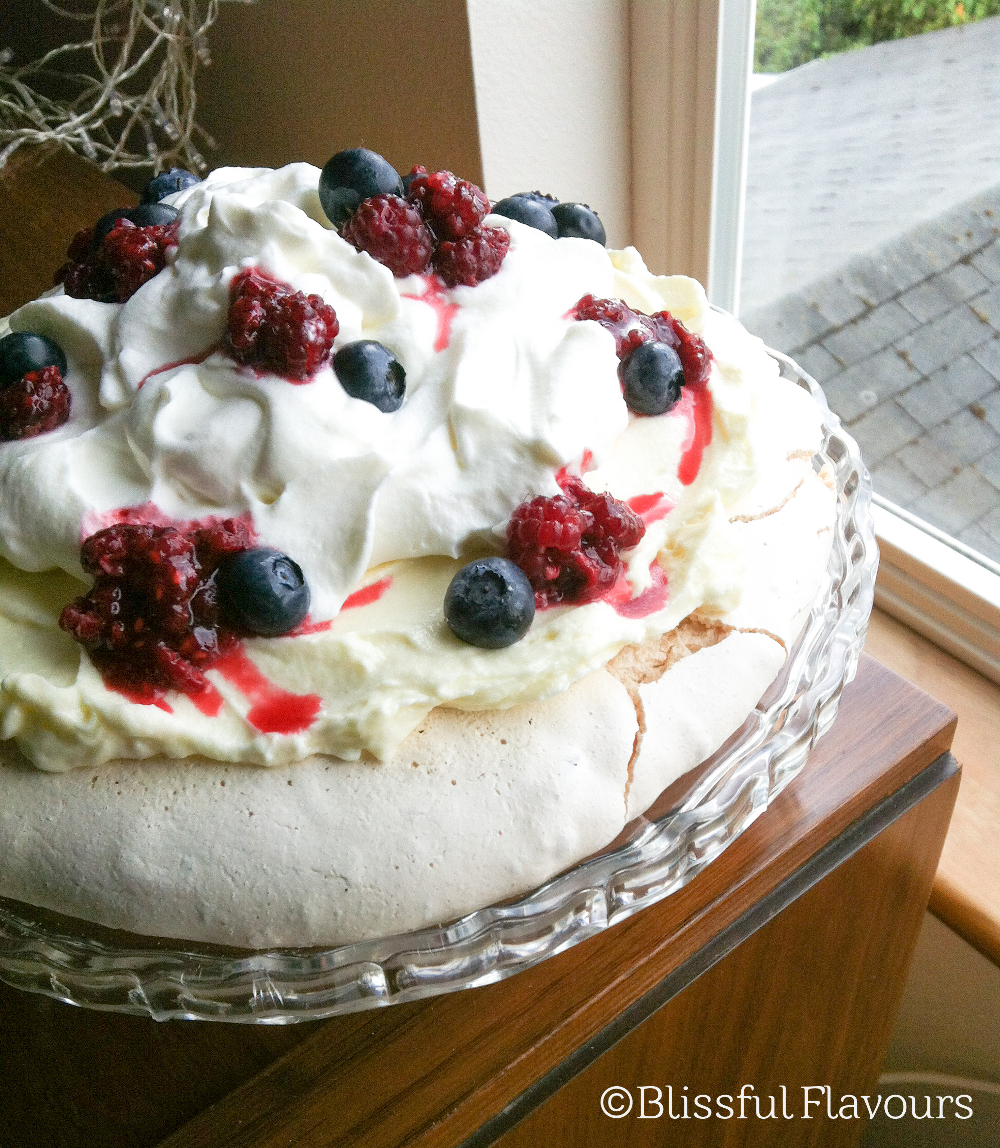A pavlova is one of those desserts one can whip up in 15 minutes, pop in the oven before dinner guests start arriving, and have for dessert a couple of hours or so later. Or, more often than not in my case, whenever your guests stop feeling so stuffed from dinner and start feeling like they have room in their stomachs for dessert. Or make the meringue ahead and keep it in an airtight container for a day or two (depending on the humidity in your area), and then put it all together just before serving.
My first encounter with Pavlova was, aptly, in Australia. I won’t get into the tussle as to where it originates from exactly, but this dish is definitely one loved by many Australians as well as New Zealanders. I had my very first taste of it in a little café somewhere in Melbourne. Granted, the way the café made it wasn’t something memorable, but I was immediately struck by the possibilities of the dessert.
The sweet meringue base is mild enough to be the foundation of a multitude of flavours, and pairs well with lightly sweetened whipped cream, fruit, fruit-based curds, etc. There’s something about the sweet crisp base combined with the billowy cream and the tart-sweetness of fruit that is a winning combination.
In the version above, I placed lime curd on the base, topped it with whipped cream and then dotted it with raspberry sorbet and fresh berries. Bites of heaven.
The secret to acing this dessert is to have light and airy whipped egg whites, cook it at a low temperature for a long time, and eat it as soon as possible – although you could wait up to within four hours of assembly.
I know some people are afraid of whipping egg whites up, but the trick is to ensure that your egg whites are completely yolk-free, and your bowl and beaters are super clean and free of grease. A little acidity helps the egg proteins unwind and aerate to their full potential, so I usually either swipe the bottom of the bowl with half a lemon, or add in cream of tartar. 1/8 teaspoon cream of tartar per egg white.
Left-over egg whites are perfect for this recipe.
Basic but Beautiful Pavlova
Adapted from thekitchn
Feeds eight greedy people or twelve regular ones
Meringue base:
Half a lemon
4 egg whites, room temperature
1 cup white sugar, the finer grained the better – but not powdered
1/2 tablespoon cornstarch
1 teaspoon vanilla extract
1 teaspoon white vinegar
Topping:
1 cup heavy cream
1 ½ tablespoons sugar
2 cups of a mixture of blueberries, raspberries and strawberries
- Preheat the oven to 275°F or 135°C with a rack in the lower third of the oven. Line a baking sheet with parchment. Trace a 9” or 10” circle on the parchment paper then flip it over.
- In a small bowl, combine the sugar and cornstarch. In a seperate bowl, mix the vanilla and white vinegar together.
- Lightly wipe the cut side of the lemon all over the base of your mixing bowl. Pour the egg whites into the bowl and begin beating at low speed. Gradually increase the speed to medium.
- Once the beaters start leaving trails in the egg whites (soft peak stage), add the sugar cornstarch mixture a few tablespoons at a time, waiting a few seconds between each addition. Once all the sugar is added, increase your beaters to maximum speed and whip just until the meringue holds stiff peaks. Be careful not to over beat.
- Add in the vanilla vinegar mixture into the meringue and beat for another 20 seconds to combine.
- Use a spatula to scrape all the meringue onto the parchment in the center of the drawn circle. Working from the inside out, spread the meringue to fill the circle. You want it to have about an inch of meringue piled higher around the edge of your circle so that your filling (whipped cream) will have something to sit in. Use the spatula to either create swirls around the edges, or smooth them down.
- Put the meringue in the oven and immediately turn the heat down to 250°F or 121°C. Bake for 60-70 minutes. The pavlova is done when the crust is dry, and sound hollow when tapped. Cracks are almost assured, but don’t worry, whipped cream can cover a multitude of sins and this dessert is meant to be a little rustic.
- Once the pavlova has finished cooking, turn off the oven and leave it inside with the door slightly open. Let sit until the pavlova is cooled – about an hour. The pavlova can be kept in an airtight container at this point.
Assembling the Pavlova:
- In a large bowl, whip the cream and sugar until they form stiff peaks. Pile into the middle of the pavlova, letting it sit well in the hollow you made earlier – leaving the 1 inch border untouched by cream. Top with fruit and serve within two hours.
Notes:
- Once the egg whites are beaten, you’ll want to bake the meringue as soon as possible to keep the maximum amount of air in your pavlova. Let it sit too long on the counter and the egg whites will start deflating, and your pavlova won’t be as fluffy.
- When I’m on a deadline and need to serve dessert asap, I’ve skipped step 8 entirely and just let the pavlova cool on it’s tray on the counter, I didn’t really notice any difference in texture other than it sinking a tiny bit more than if I had left it to cool in the oven.
- Humidity is an enemy of this dessert as it will soften the meringue base. If you are making this ahead in humid weather, I recommend wrapping well in plastic wrap and then sealing it again in an airtight container.
- Playing around with the fillings is half the fun of this dessert. The possibilities are endless really. Fruit curds, sorbets and ice-creams all get along beautifully with it.
- The higher you can pile your whipped cream and fruit, and the more colours you use in this dessert have a direct impact on the visual your guests will have of the dessert, people eat with their eyes first, but the taste at the end of the day is still important, and in this, pavlova never fails to disappoint.



Yum pavlova is the best
LikeLike
Yes it is! 🙂
LikeLike